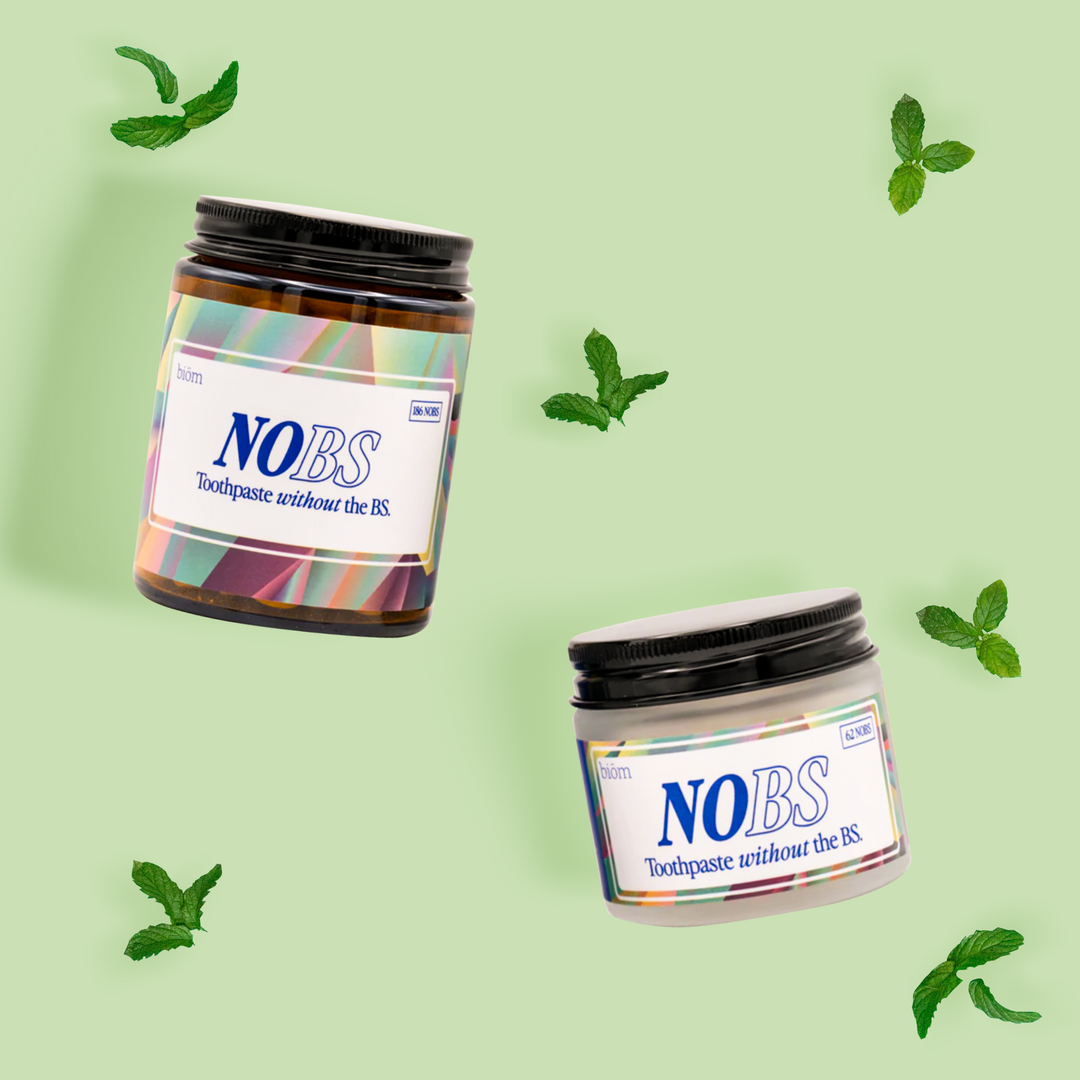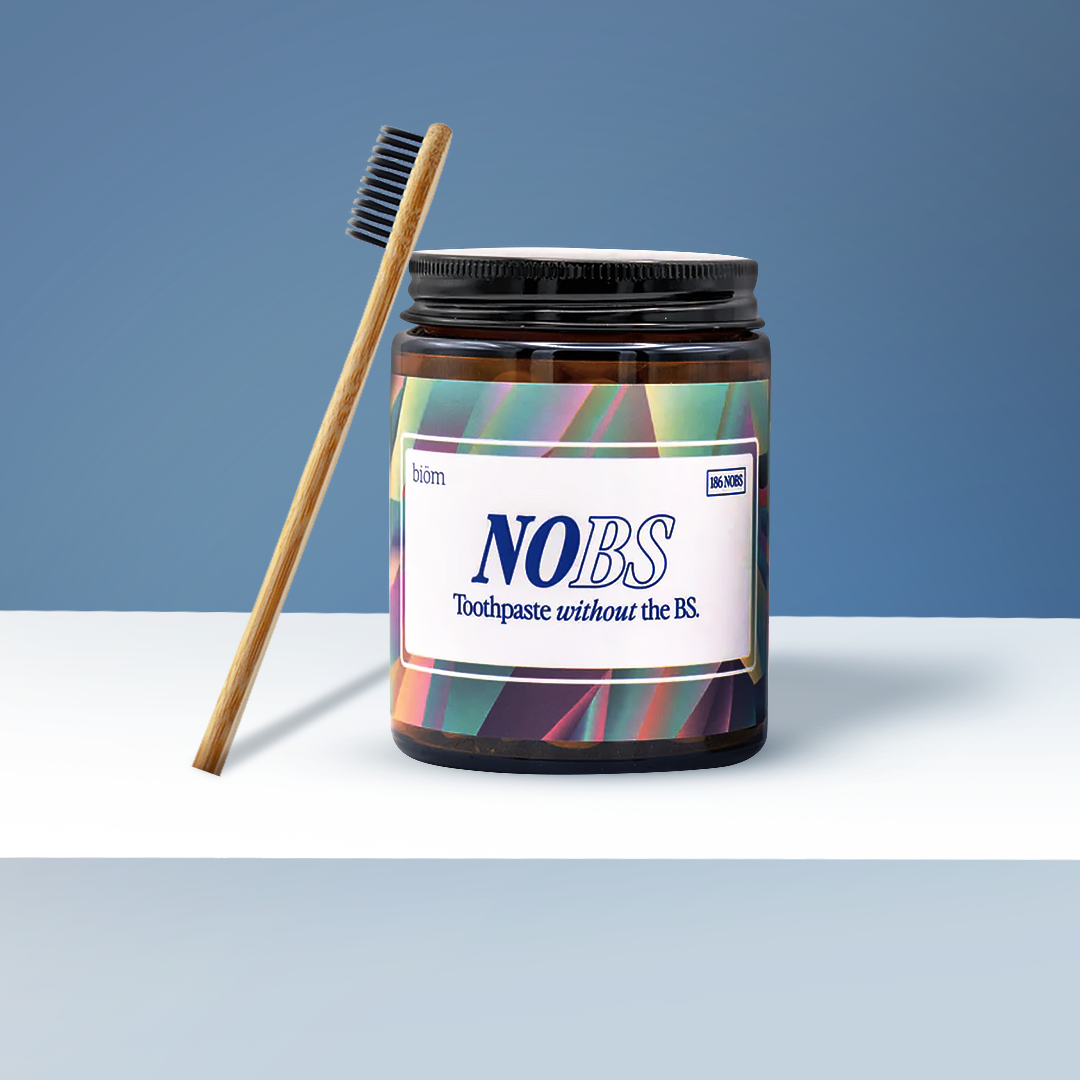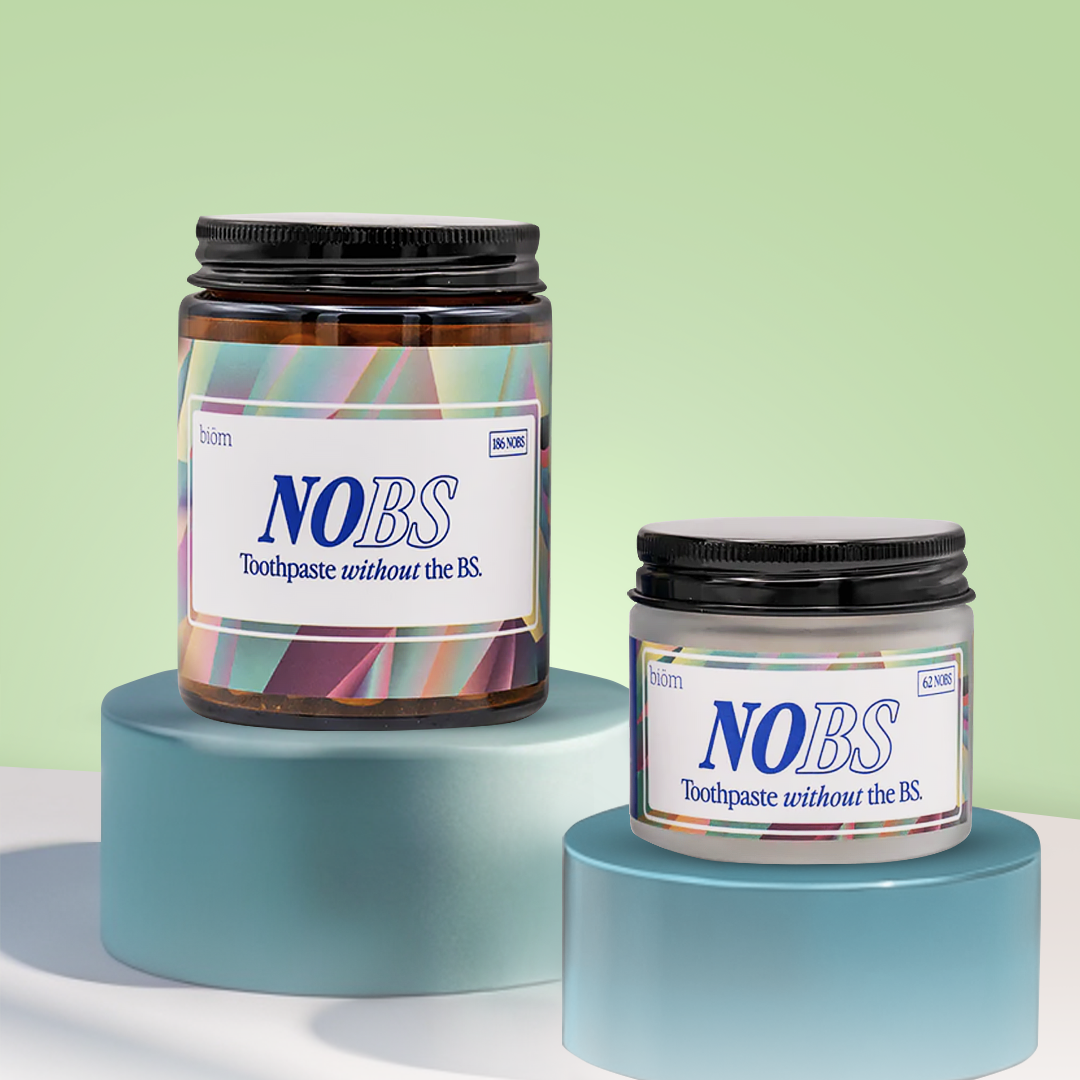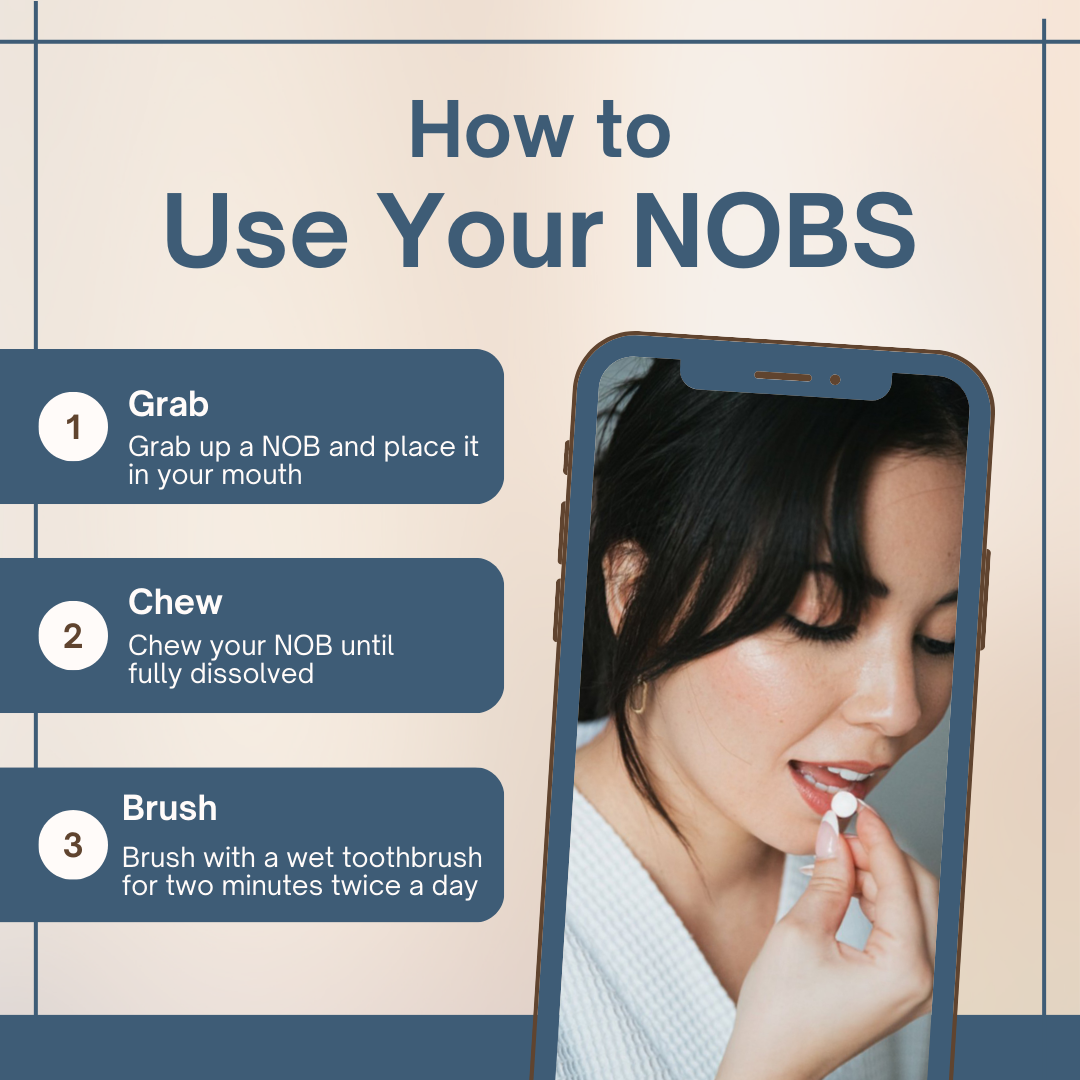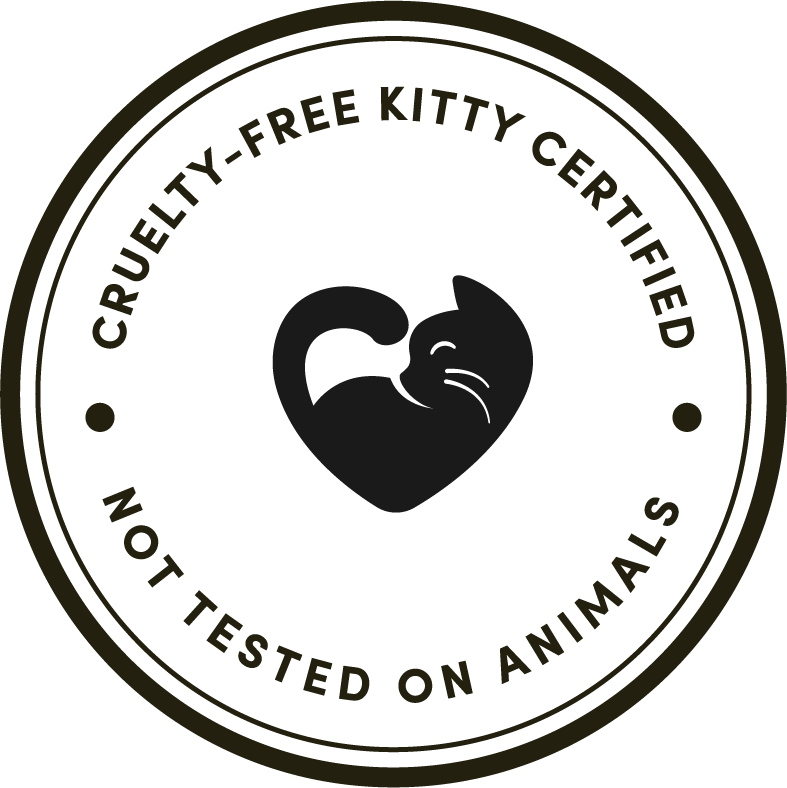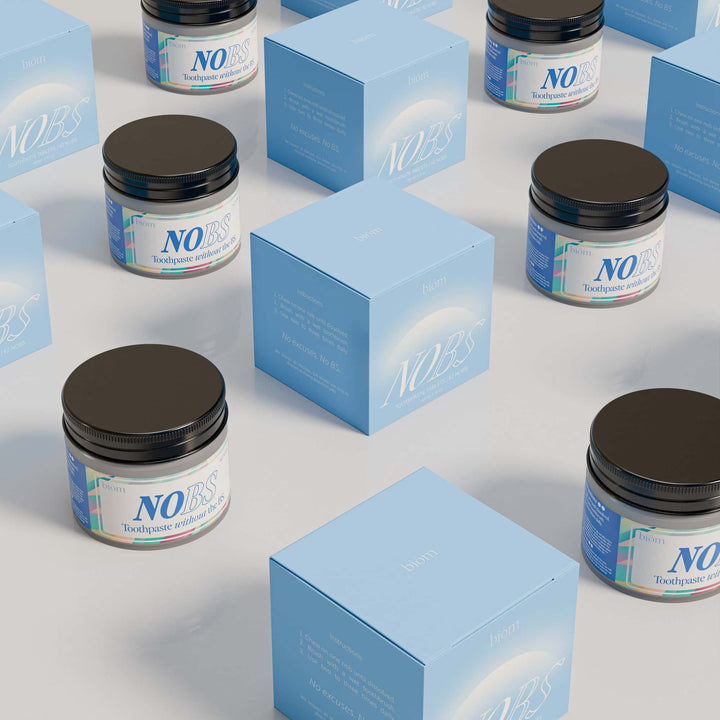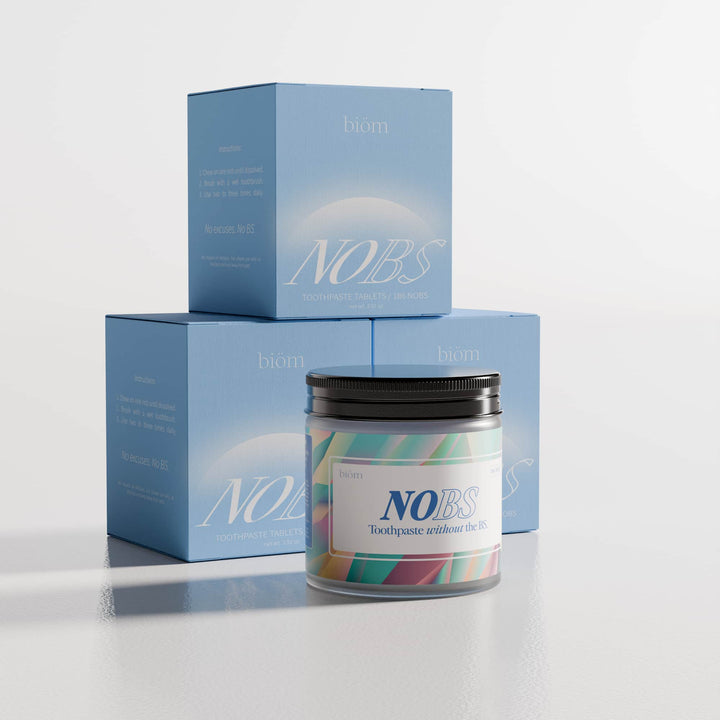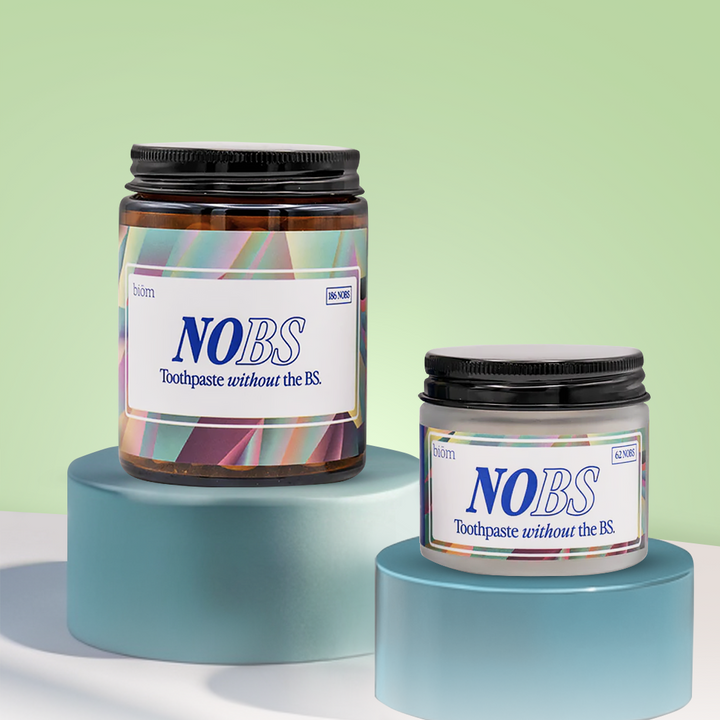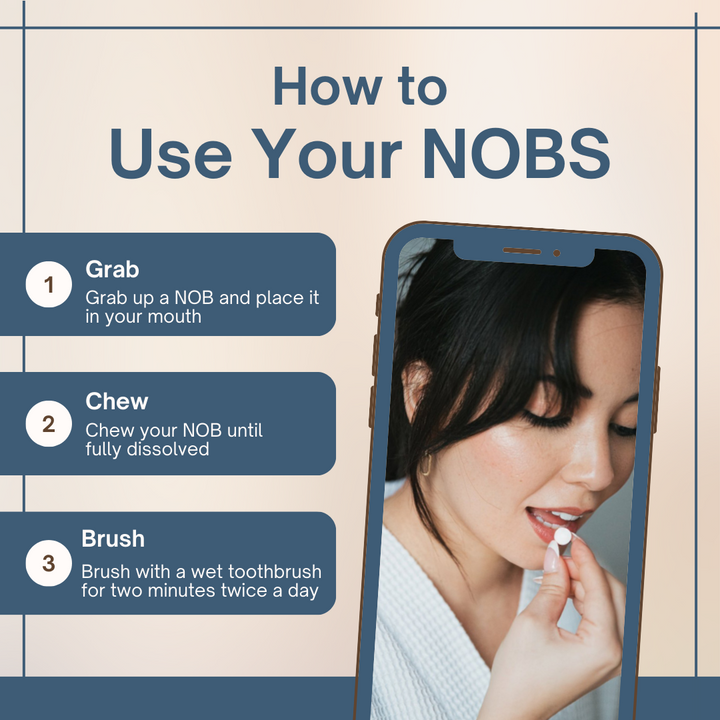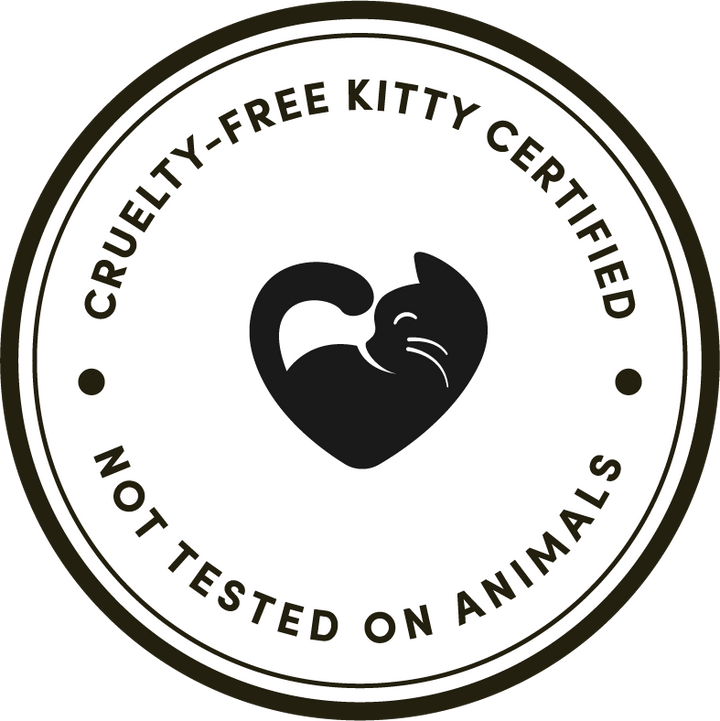Hydroxyapatite vs Nano Hydroxyapatite
Both nano hydroxyapatite and hydroxyapatite are forms of the same naturally occurring mineral that makes up our teeth and bones. Recently, they've both been making waves in regenerative dentistry as alternatives to fluoride.
While they're similar in structure, there are some big differences. For example, because nano hydroxyapatite particles are far smaller than hydroxyapatite, nano hydroxyapatite toothpaste is more effective at fighting tooth decay, remineralizing enamel, and soothing hypersensitivity.
That said, while nano hydroxyapatite is more effective in toothpaste than hydroxyapatite, hydroxyapatite has a broader range of applications such as more frequent use in orthopedic implants and bone grafts.
In this article, I'll explain everything you need to know about nano hydroxyapatite and hydroxyapatite and what makes them different.
What is nano hydroxyapatite?

Nano hydroxyapatite (also known as nHA) is a synthetic form of hydroxyapatite, a naturally occurring mineral found in our teeth and bones. It's known for its similarity to the mineral component of our teeth, making it a valuable ingredient in remineralizing toothpaste.
Nano hydroxyapatite is created by breaking down hydroxyapatite into nanoscale particles, which are extremely small and have unique properties. Despite its small size, this nano hydroxyapatite works by:
-
remineralize tooth enamel
-
repair initial stages of tooth decay
-
strengthen the tooth structure
-
and soothe tooth sensitivity.
These benefits occur because when nano hydroxyapatite is applied to the enamel surface, it can bond with the tooth's natural hydroxyapatite, repairing and strengthening the enamel.
Studies suggest that nano hydroxyapatite is equally as effective as fluoride toothpaste at remineralization and preventing dental caries. Due to some of the concerns around fluoride toxicity, many people prefer nano hydroxyapatite as a better alternative to fluoride.
What is hydroxyapatite?

Hydroxyapatite (also referred to as simply "HA") is a naturally occurring mineral that is the primary inorganic component of human teeth and bones.
It is a crystalline structure composed of calcium and phosphate ions, making it a vital component of the hard tissues in our bodies. In fact, hydroxyapatite gives our teeth and bones their strength and hardness.
In the context of teeth, hydroxyapatite is a key component of tooth enamel, which is the outermost layer of the tooth surface. Enamel is the hardest substance in the human body, and it protects the underlying dentin and pulp of the tooth.
Hydroxyapatite is also used in various dental and medical applications, including dental implants, bone grafts, and as a biomaterial in orthopedic surgery.
Nano Hydroxyapatite vs. Hydroxyapatite

Nano hydroxyapatite (nano-HA or nHA) and hydroxyapatite (HA) are both forms of the mineral hydroxyapatite, but they differ in terms of particle size, applications, and properties.
Natural vs. Synthetic
First, the nano hydroxyapatite in your toothpaste is likely synthetic nHA that was created in a laboratory through controlled chemical processes. Even though some people may be uncomfortable with synthetic materials, nano hydroxyapatite is safe and effective.
Similarly, synthetic hydroxyapatite is produced for various applications, including dental and medical uses.
However, hydroxyapatite can also be found naturally in human teeth and bones. Natural sources include animal-derived hydroxyapatite from sources like bovine bone or fish scales.
Particle Size

Nano hydroxyapatite consists of nanoscale particles, typically with dimensions in the range of tens to hundreds of nanometers. Its small particle size allows for greater surface area and improved bioavailability.
This is why nano hydroxyapatite particles can be so advantageous in regenerative dentistry.
On the other hand, traditional hydroxyapatite consists of much larger particles than nano sized particles, typically in the micrometer range. While hydroxyapatite is still a fine powder, it does have a lower surface area compared to nano hydroxyapatite.
This is why hydroxyapatite toothpastes tend to be less effective than nano hydroxyapatite toothpastes.
Biocompatibility
Experts agree both nano hydroxyapatite and hydroxyapatite are safe and biocompatible substances that closely resemble the natural mineral composition of our teeth and bones.
Applications

Nano hydroxyapatite is most popular for its use in dental products, thanks to its benefits of oral biofilm management, preventing tooth decay, and soothing hypersensitivity. This is because it has a particularly small particle size which allows it to penetrate and remineralize tooth enamel effectively.
Similarly, hydroxyapatite is also used in dentistry but not as commonly as nano hydroxyapatite.
Both nHA and HA have a broad application range, including:
-
orthopedic and dental implants
-
bone grafts
-
and other various medical applications.
In particular, dental professionals use nano hydroxyapatite toothpaste as a better alternative to fluoride.
Remineralizing Properties
Nano hydroxyapatite is well-known for its remineralizing properties. In fact, it's one of the best treatments for tooth decay and sensitivity.
Remineralization is essential for maintaining the integrity of our teeth and is a continuous, natural repair mechanism to restore minerals to the tooth enamel.
While hydroxyapatite toothpaste can also be effective for remineralization, studies suggest that it is not as effective as nano hydroxyapatite toothpaste.
Aesthetic Benefits

Nano hydroxyapatite is known for its ability to improve your smile, including benefits like:
-
whitening teeth
-
reducing discoloration
-
and improving the glossiness and hardness of teeth.
In contrast, research suggests hydroxyapatite toothpaste may not be as effective as nano hydroxyapatite toothpaste in providing these aesthetic benefits.
Safety
Because of their biomimetic nature, both nano hydroxyapatite and hydroxyapatite are generally considered safe for various applications, including use in toothpaste.
In particular, experts suggest that nano hydroxyapatite has low toxicity and minimal risk of adverse effects.
Benefits of Nano Hydroxyapatite Toothpaste

Nano hydroxyapatite toothpaste tablets are making waves for all of the incredible benefits they offer for your teeth. Here in this section, we'll explore 6 of the most important ones.
Enamel Remineralization
If you're wondering how to remineralize teeth, nano hydroxyapatite toothpaste should be one of your go-to tools.
Nano hydroxyapatite functions to strengthen your enamel surface and increase the mineral density of your teeth. This process makes your teeth stronger and glossier while also decreasing your chances of tooth decay, leading to a radiant smile!
Strengthen Teeth
Nano hydroxyapatite toothpaste is effective at strengthening teeth thanks to its remineralization properties.
You see, when our teeth are exposed to acids, it can wear away at our enamel through a process called demineralization. This leads to weakened enamel, tooth decay, and even carious lesions.
Thanks to nano particles, nano hydroxyapatite toothpastes can penetrate the enamel and bond with the natural hydroxyapatite in our teeth. This remineralization process restores the lost minerals in our teeth (primarily calcium and phosphate), and makes our teeth stronger and more resistant to damage.
Further, over time, studies show that regularly using nano hydroxyapatite toothpaste can improve enamel density and hardness, which reduces your risk of erosion and decay.
Prevent Tooth Decay & Cavities

While nano hydroxyapatite does not have the same FDA approval for dental caries prevention as fluoride, studies show that it does indeed help remineralize initial caries lesions.
This process can stimulate bone growth leading to reduced chances of developing decayed enamel.
While it is true that you cannot remineralize a cavity once it has fully formed, this evidence shows that nano hydroxyapatite is effective at reversing tooth decay and preventing it from progressing.
Reduce Hypersensitivity
Even beyond caries prevention, synthetic hydroxyapatite is an effective desensitizing agent. Research shows that it is a safe material for reducing dentin hypersensitivity.
By depositing minerals into the protective layer of your teeth, hydroxyapatite toothpaste can make a significant difference in your ability to tolerate acidity, temperature, and sugar.
Whiten Teeth

Fun fact: nano hydroxyapatite toothpaste can whiten teeth.
Nano hydroxyapatite has the ability to gently remove surface stains from teeth, leading to a brighter, whiter smile. In fact, one study suggested: "[hydroxyapatite is] an effective dental whitening agent in over-the-counter oral care products for home use."
The best part about this benefit is that nano hydroxyapatite toothpaste can replace your typical abrasive whitening toothpaste which can lead to enamel damage and isn't suitable for children to use.
Support Your Oral Microbiome
A healthy mouth has a unique environment of bacteria in it. Using synthetic hydroxyapatite is helpful in reducing the growth of bad bacteria while sparing the good bacteria that protect your teeth.
Additionally, many common agents in oral care can disrupt your microbiome, such as:
-
chlorhexidine
-
hydrogen peroxide
-
and sodium lauryl sulfate
These ingredients may lead to issues like sensitive teeth and dry mouth. Nano hydroxyapatite toothpaste protects your mouth from these negative effects.
FIGHTS BAD BACTERIA

Nano hydroxyapatite toothpaste, unlike fluoride, has unique antibacterial properties. By selectively killing off certain strains of bacteria that disrupt your mouth, hydroxyapatite protects your teeth and gums.
PREVENT DENTAL FLUOROSIS
Excessive use of fluoride products in dental care causes the discoloration of your teeth through a condition called dental fluorosis.
Therefore, switching to a more natural formula, such as nano hydroxyapatite toothpaste can help preserve the beauty of your smile.
Safe for Children
Nano hydroxyapatite is considered by many dentists as a better alternative to fluoride for children for a number of developmental and physical reasons.
For example, some researchers suggest hydroxyapatite is a promising solution early childhood caries. Further, a meta analysis concluded that, "biomimetic hydroxyapatite-containing, fluoride-free oral care products are effective in reducing dental decay, especially in children."
Finally, another study using the International Caries Detection and Assessment System concluded, at the end of a year-long trial, that hydroxyapatite toothpaste was not inferior to a fluoride control toothpaste.
Does nano hydroxyapatite remineralize teeth?
Yes, nano-hydroxyapatite (nHA) can homogeneously remineralize teeth by restoring lost minerals in enamel.
Studies indicate that it mimics the natural structure of tooth material, making it highly effective for enamel repair. Furthermore, it fills microscopic cracks and lesions, which strengthens both weakened enamel and dentin.
Unlike fluoride, nHA binds directly to damaged areas, forming a protective layer over the teeth to shield them from further damage. Studies also suggest that it is particularly useful in preventing sensitivity by sealing exposed dentinal tubules.
In addition, it promotes smooth, glossy teeth and reduces plaque adhesion. With its ability to remineralize and protect teeth, nHA is a safe and reliable alternative to fluoride for maintaining strong and healthy teeth.
Is nano hydroxyapatite better than hydroxyapatite?

Yes, nano hydroxyapatite is generally better than hydroxyapatite for remineralization and enamel strengthening benefits.
In fact, one paper from 2023 even stated, "Compared to HA, nHA is found to have superior properties such as increased solubility, high surface energy and better biocompatibility. This is due to the morphological and structural similarity of nanosized hydroxyapatite particles to tooth hydroxyapatite crystals."
Essentially, because hydroxyapatite nanoparticles are so small, they're better able to integrate into the tooth structure and remineralize enamel. Therefore, nano hydroxyapatite toothpastes provide increased oral hygiene benefits over hydroxyapatite toothpastes.
Is nano hydroxyapatite toothpaste better than fluoride toothpaste?

Yes, nano hydroxyapatite can be considered better than fluoride as it offers similar benefits without the associated toxicity.
It provides the advantages of fluoride, such as enamel protection, sensitivity reduction, and remineralization, but without the potential harm linked to fluoride ingestion. For example, research suggests that nano hydroxyapatite is non-toxic and safe enough to swallow, unlike fluoride which can cause dental and skeletal fluorosis if overexposed.
The same case can be made when comparing hydroxyapatite vs fluoride as well, but as discussed earlier, evidence suggests that hydroxyapatite is not quite as effective as nano hydroxyapatite.
That's why we recommend choosing nano hydroxyapatite toothpaste - it can be a safer and better alternative for oral care.
What's the best concentration of nano hydroxyapatite toothpaste?
While some people erroneously suggest that you need 10% nano hydroxyapatite in toothpaste, the most effective concentration of nano hydroxyapatite is 5%.
For example, one double-blind study found that 5% nano hydroxyapatite toothpaste showed significant anti-caries remineralization effects on enamel. Another study showed that 5% and 10% nano hydroxyapatite dentifrices were equally effective at remineralizing teeth.
While some studies show the efficacy of 10% nHA toothpaste, one potential issue is the aggregation property of nano hydroxyapatite at higher concentrations which may reduce bioavailability. Because of this aggregation property, a recent study found that 5% nano hydroxyapatite is more effective at remineralization than 10%.
Further, because nano hydroxyapatite is such an expensive material, it is likely that brands formulating it at a 10% concentration are using the cheapest version: needle-shaped nano hydroxyapatite. As of 2024, needle-shaped nHA is banned in the European Union due to safety concerns.
In contrast, biöm uses safe 5% rod-shaped nano hydroxyapatite in our toothpaste tablets, and all of our toothpaste is manufactured in FDA-compliant facilities.
Should you try nano hydroxyapatite toothpaste?

Yes, you should try nano hydroxyapatite toothpaste as it offers the same benefits as fluoride toothpastes without any adverse effects. Further, it has been shown to be more effective than standard hydroxyapatite toothpastes.
Research has also indicated that nano hydroxyapatite can effectively whiten teeth by reducing stains and enhancing their whiteness.
Therefore, incorporating nano hydroxyapatite toothpaste into your oral care routine can be a safe and beneficial choice for maintaining good oral health.
Summary: Nano Hydroxyapatite vs. Hydroxyapatite

Nano hydroxyapatite and hydroxyapatite are both forms of the same compound, but they differ slightly in efficacy and benefits.
Because nano hydroxyapatite particles are much smaller than hydroxyapatite, nano hydroxyapatite toothpaste is more effective at:
-
preventing tooth decay
-
strengthening teeth
-
soothing hypersensitivity
-
whitening teeth and reducing discoloration
That said, hydroxyapatite tends to have a broader range of applications than nano hydroxyapatite which is primarily used as a tool in dentistry to remineralize teeth.
In conclusion, if you're looking for an alternative to fluoride toothpaste, be sure to check out remineralizing toothpaste with nano hydroxyapatite for all the best benefits.
Frequently Asked Questions
Is nano hydroxyapatite better than regular hydroxyapatite?
Yes, nano hydroxyapatite is generally better than hydroxyapatite for remineralization and enamel strengthening benefits. Essentially, because hydroxyapatite nanoparticles are so small, they're better able to integrate into the tooth structure and remineralize enamel. Therefore, nano hydroxyapatite toothpastes provide increased oral hygiene benefits over hydroxyapatite toothpastes.
Why is nano hydroxyapatite banned?
Rod-shaped nano hydroxyapatite is not banned in the United States or the European Union. In fact, it is approved for use up to 10% concentration in toothpaste. However, needle-shaped nano hydroxyapatite is banned in the European Union for suspicion of causing cell damage if ingested in large quantities.
What is the best form of hydroxyapatite?
The best form of hydroxyapatite for strengthening teeth is nano hydroxyapatite. Thanks to its small size, nano hydroxyapatite is effective at remineralizing teeth, strengthening enamel, fighting tooth decay, and reducing hypersensitivity. Research even suggests that it is equally as effective as fluoride toothpaste at remineralization.
Is nano hydroxyapatite toxic?
No, nano hydroxyapatite is not toxic. In fact, research suggests that because it does not induce toxicity or inflammation, it's an ideal compound to use in dentistry and periodontology. Further, many people are turning to nano hydroxyapatite toothpaste as a safe, non-toxic alternative to fluoride toothpaste.
What are the disadvantages of nano hydroxyapatite?
There are no known disadvantages or side effects of nano hydroxyapatite in toothpaste. Research states that there is no literature reporting any systemic or adverse effects of hydroxyapatite containing toothpastes. In fact, that's why many people are turning to nano hydroxyapatite toothpaste as a safe, non-toxic alternative to fluoride toothpaste.
What is the problem with hydroxyapatite?
There is no problem with hydroxyapatite. In fact, there are no known disadvantages or side effects of nano hydroxyapatite in toothpaste. Research states that there is no literature reporting any systemic or adverse effects of hydroxyapatite containing toothpastes. That's why many people are turning to nano hydroxyapatite toothpaste as a safe, non-toxic alternative to fluoride toothpaste.
Does nano-hydroxyapatite remineralize teeth?
Yes, nano-hydroxyapatite (nHAp) can help remineralize teeth. This naturally occurring mineral mimics the structure of tooth enamel, allowing it to bond to weakened areas and restore lost minerals. It can also reduce tooth sensitivity by filling microscopic cracks in enamel, promoting overall dental health.
Do I need a prescription to order nano-hydroxyapatite?
No, you typically do not need a prescription to order nano-hydroxyapatite (nHAp) products. Many over-the-counter toothpaste, mouthwashes, and dental care products contain nHAp and are available for purchase without a prescription.
Does hydroxyapatite promote enamel regrowth?
Yes, hydroxyapatite, especially in its nano form, promotes enamel regrowth by replenishing lost minerals and repairing weakened areas of the enamel. It mimics the natural structure of tooth enamel, allowing it to bond and integrate with existing enamel, helping strengthen and protect teeth from further damage. However, it does not regrow enamel once it’s completely worn away.
Where does hydroxyapatite come from?
Hydroxyapatite is a naturally occurring mineral found in bones and teeth, making up the primary component of human enamel. It can be derived from natural sources, like animal bones, or synthesized in labs for dental products. Synthetic hydroxyapatite used in toothpaste mimics the structure of natural enamel to aid in remineralization.
Where is nano-HAp found?
Nano-hydroxyapatite (nano-HAp) is found in dental products like toothpaste and oral care treatments, where it is used to restore and protect tooth enamel. It is a synthetic version of the naturally occurring hydroxyapatite found in human teeth and bones. Nano-HAp is also used in medical applications, such as bone grafts and implants, due to its biocompatibility.
How does nano-HAp feel on your teeth?
Nano-hydroxyapatite (nano-HAp) feels smooth and gentle on your teeth, often providing a clean, polished sensation after brushing. It helps fill microscopic cracks in the enamel, reducing sensitivity without any gritty texture. Over time, it can leave your teeth feeling stronger and more protected.
Is hydroxyapatite safe?
Yes, hydroxyapatite is considered safe and is biocompatible, meaning it naturally integrates with the body. It has been used in medical and dental applications for decades, including toothpaste, bone grafts, and implants. Studies show it is non-toxic and effective in strengthening and protecting tooth enamel.
Can nano-hydroxyapatite reverse cavities?
Nano-hydroxyapatite can help reverse early-stage cavities by promoting the remineralization of tooth enamel. It works by filling in microscopic defects in the enamel and restoring minerals lost due to demineralization. However, it is most effective on incipient lesions and may not be able to repair more advanced cavities that require dental intervention.
Is Nano-hydroxyapatite Safe?
Yes, nano-hydroxyapatite is safe for use in dental products. It is biocompatible, meaning it does not cause adverse reactions when used in the body, and has been shown to effectively remineralize teeth without harmful effects. However, it's always best to use products as directed and consult a healthcare professional if you have specific concerns.
Why should you try nano hydroxyapatite containing toothpaste?
Using toothpaste with nano hydroxyapatite can help remineralize enamel, making your teeth stronger and more resistant to decay. It also aids in reducing tooth sensitivity by sealing exposed dentin and creating a protective barrier. Additionally, nano hydroxyapatite is a safe alternative to fluoride for those who prefer fluoride-free oral care products.
Is nano-hydroxyapatite the same as hydroxyapatite?
Nano-hydroxyapatite and hydroxyapatite are related but not the same. Hydroxyapatite is a naturally occurring mineral form of calcium apatite, primarily found in bones and teeth, while nano-hydroxyapatite refers to a synthetic form with particle sizes in the nanometer range, enhancing its effectiveness in dental products. The nano-sized particles improve the material's bioavailability and ability to remineralize enamel and reduce sensitivity.
Is nano hydroxyapatite bad for you?
No, nano hydroxyapatite is generally considered safe for use in dental products, as it is biocompatible and mimics the natural structure of tooth enamel. Studies have shown it can help remineralize teeth and reduce sensitivity without adverse effects. However, as with any substance, it's essential to follow recommended guidelines and consult a healthcare professional if you have concerns.
Does nano-hydroxyapatite rebuild teeth?
Yes, nano-hydroxyapatite (nHA) can rebuild teeth by restoring lost minerals and strengthening enamel. Studies suggest that nHA mimics the natural composition of teeth, filling in microscopic cracks and repairing damaged areas. This makes it effective in rebuilding enamel, reducing sensitivity, and protecting teeth from further damage.
What are the disadvantages of hydroxyapatite?
There are no known disadvantages or side effects of nano hydroxyapatite in toothpaste. Research states that there is no literature reporting any systemic or adverse effects of hydroxyapatite containing toothpastes. In fact, that's why many people are turning to nano hydroxyapatite toothpaste as a safe, non-toxic alternative to fluoride toothpaste.
How long does it take for nano hydroxyapatite to work?
Nano-hydroxyapatite (nHA) begins working immediately by filling in microscopic cracks and strengthening enamel, but noticeable results can take a few weeks of consistent use. Studies suggest that sensitivity relief may occur within days, while significant enamel remineralization may take two to three months. Regular use ensures ongoing protection and improvement in overall tooth health.
Is nano hydroxyapatite FDA approved?
Yes, nano hydroxyapatite is regarded as safe and is approved for use in dental care products by the FDA. It is commonly found in toothpaste and other oral health products due to its effectiveness in strengthening teeth and promoting remineralization. Its biocompatibility makes it a popular choice for those looking for alternatives to fluoride.





